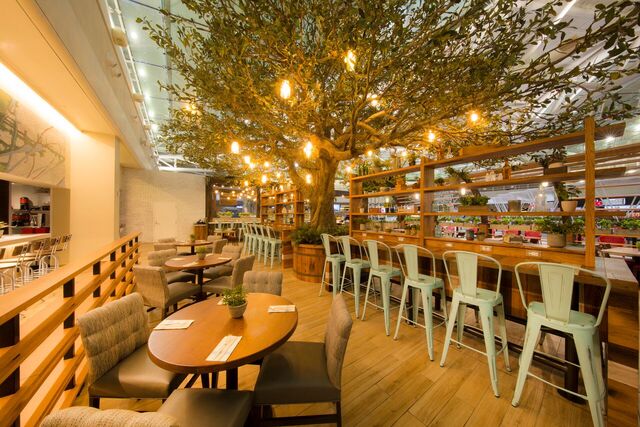
The Cask & Larder restaurant was a revelation to Orlando International Airport when it opened in October 2016.
The restaurant offers dishes such as shrimp and grits, Nashville fried chicken and other Southern classics. It helped show airport officials that people don’t just want food when they travel — they want good food and are willing to pay for it.
The airport showed a 24 percent increase in food sales after Cask & Larder opened, also attributable to new food options such as Chipotle, far outpacing the 7 percent increase in passenger traffic.
The Orlando airport is the latest flying hub to discover the local and fresh trend that has swept the restaurant industry. Some in the travel industry are calling it “farm to terminal” — a reference to the popular farm-to-table trend in American restaurants — to describe more cuisine options inside the nation’s airports.
OIA is ready to offer more restaurant options. A Bahama Breeze restaurant is under construction in the B Terminal, a boutique brand from Orlando-based Darden Restaurants known for its Caribbean-style food and happy hour drink offerings.
“It generally works out well because the travelers are getting something that is more authentic to the location,” said Henry Harteveldt, a travel industry analyst with San Francisco-based Atmosphere Research Group. “Maybe it’s a restaurant you couldn’t visit while you were in town or couldn’t get a reservation. Maybe it was something you loved and want one more taste.”
Since 2001 and the addition of TSA security checks, airports have been evolving to take advantage of the time passengers spend at the airport. The average passenger now spends 75 minutes at large airports such as OIA once they check in and pass security, according to a 2016 study from the Airports Council International-North America.
Airports in Atlanta, Newark and Dallas have pushed to bring in more local restaurant names, hoping departing passengers will be drawn to local favorites and incoming and connecting flyers will spend more on popular regional dishes as opposed to fast food or ubiquitous chain restaurants.
Some airport restaurants are flying in fish fresh from Japan daily for sushi.
Bonnie Smetzer, of Sebastian, said she is a more frequent OIA diner since Cask & Larder opened. Smetzer, who was eating grilled chicken with coleslaw while waiting for her flight to an apartment managers’ conference in Washington, D.C., wants better eating options at the airport.
“I wish there were more high-end restaurants here,” she said. “It’s nice to have better food so you aren’t just eating just to eat.”
The new Bahama Breeze at OIA will join a Taco Loco, a new brand from airport restaurant operator HMS Host, as well as a new deli and pizza restaurant called MCO Market and a redesigned Burger King.
“We will always have the fast food options because we have so many families coming in and out of Orlando,” said Tracy Conner Harris, the manager of concessions for the Greater Orlando Aviation Authority. “But we’ve found a lot of people want something better and if we can get them to eat here instead of stopping on the way, that’s great for everyone.”
OIA made a $24.2 million profit from food and beverage sales in the 2016 fiscal year that ended in June — 44 percent more than in 2011. It’s a growing fraction of the airport’s $286 million in non-airline revenue, which also includes retail, parking and car rental fees. Every dollar of additional revenue can help lower costs for flyers by lowering fees charged to airlines, Harris said.
The airport gets a cut, depending on the type of product sold, ranging from 8 percent to 22 percent on each purchase.
Opening a restaurant at the airport does have some obstacles. Restaurants usually need to partner with a concessions company, such as HMS Host at Orlando International, and follow safety rules such as tethering knives to work stations for eateries behind security lines.
The success of Cask & Larder could be a big influence as the airport prepares to open its new south terminal in 2021, a blank slate to experiment with new food and retail concepts, Harris said.
Even with the new options, Orlando is still trying to keep up with airports such as Hartsfield-Jackson in Atlanta, which has brought in local favorites The Varsity (a famous burger spot), Versano’s pizzeria and One Flew South, an original restaurant that partners with local farmers for produce and meat.
“We always want people to know they are in Atlanta, Georgia,” said Chilly Ewing, director of Concessions for Hartsfield-Jackson Atlanta International Airport. “Sometimes when you travel, it’s hard to determine where you are at. Everything just blends together.”
By karnold@orlandosentinel.com, @kylelarnoldor facebook.com/bykylearnold



